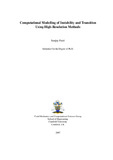JavaScript is disabled for your browser. Some features of this site may not work without it.
| dc.contributor.advisor | Drikakis, Dimitris | |
| dc.contributor.author | Patel, Sanjay | |
| dc.date.accessioned | 2009-03-04T10:42:50Z | |
| dc.date.available | 2009-03-04T10:42:50Z | |
| dc.date.issued | 2007 | |
| dc.identifier.uri | http://hdl.handle.net/1826/3235 | |
| dc.description.abstract | This thesis concerns the numerical investigation of suddenly expanded flows featuring separation, instabilities and transition, in the context of Implicit Large Eddy Simulation (ILES). The study of separated flows through suddenly expanded geometries is a classic yet complex area of research. These types of flows feature instabilities which may lead to bifurcation. Non-linear bifurcation is of great importance when considering hydrodynamic stability and the mechanism of laminar to turbulent flow transition. A detailed numerical investigation of various high-resolution methods and their ability to correctly predict the flow through a suddenly expanded and contracted geometry demonstrates that the choice of the particular numerical method employed can lead to an incorrect solution of the flow. The key di erence between the various highresolution methods employed is in the calculation of the nonlinear wave-speed dependent term. It is shown that the nonlinearity of this term provides an asymmetric dissipation to the flow which triggers symmetry-breaking bifurcation in a fully symmetric computational set-up. High-resolution simulations of three-dimensional flow through a plane suddenly expanded channel at low Reynolds numbers show that this type of flow is characterised by a symmetric separation of the fluid which is nominally two-dimensional in the spanwise direction. Increasing the Reynolds number reveals a symmetry-breaking bifurcation of the fluid flow which becomes three-dimensional as Reynolds number is further increased. Simulations confirm that it is this threedimensional disturbance which leads to the onset of time-dependent flow characterised by the periodic shedding of vortices from the upstream recirculation zones. Preconditioning techniques which aim to alleviate sti ness in the calculation of the advective fluxes for low Reynolds number flows are shown to be unsuitable for flows featuring instabilities. The added dissipation to the flow causes the prediction of an incorrect stable solution or to an improper estimation of the size of the separation bubbles. Simulations of a synthetic jet issuing into quiescent air using various slope limiters manage to capture the flow physics relatively well. Limiters are used to avoid a scheme from being oscillatory and provide non-linear dissipation in the region of excessively large gradients. The various limiters di er with regards to the amount of dissipation they provide to the flow, hence the solution obtained is dependent on the limiter used. | en_UK |
| dc.language.iso | en | en_UK |
| dc.publisher | Cranfield University | en_UK |
| dc.rights | © Cranfield University, 2007. All right reserved. No part of this publication may be reproduced without the written permission of the copyright holder. | en_UK |
| dc.title | Computational modelling of instability and transition using high-resolution methods | en_UK |
| dc.type | Thesis or dissertation | en_UK |
| dc.type.qualificationlevel | Doctoral | en_UK |
| dc.type.qualificationname | PhD | en_UK |
